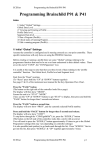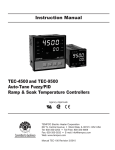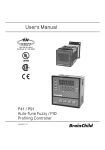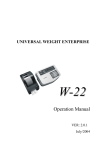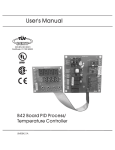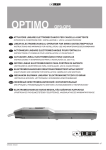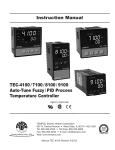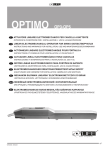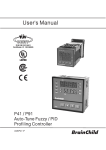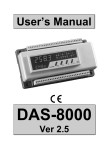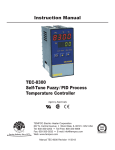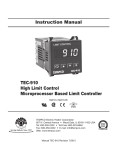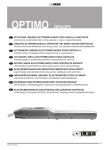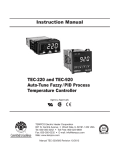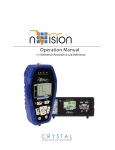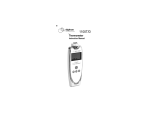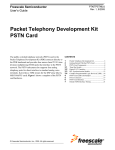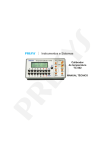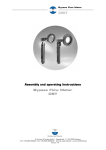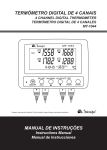Download TEC 4500, 9500 Manual - Tempco Electric Heater Corporation
Transcript
Instruction Manual TEC-4500 and TEC-9500 Auto-Tune Fuzzy/PID Ramp & Soak Temperature Controllers Agency Approvals Serving Industry Since 1972 TEMPCO Electric Heater Corporation 607 N. Central Avenue • Wood Dale, IL 60191-1452 USA Tel: 630-350-2252 • Toll Free: 800-323-6859 Fax: 630-350-0232 • E-mail: [email protected] Web: www.tempco.com Manual TEC-4500/9500 Revision 7/2015 NOTES ii Warning Symbol This symbol calls attention to an operating procedure, practice, or the like which, if not correctly performed or adhered to, could result in personal injury or damage to or destruction of part or all of the product and system. Do not proceed beyond a warning symbol until the indicated conditions are fully understood and met. Using the Manual Installers . . . . . . . . . . . . . . . . . . . . . . . . . . . Read Chapter 1, 2 System Designer . . . . . . . . . . . . . . . . . . . . . Read All Chapters Expert User . . . . . . . . . . . . . . . . . . . . . . . . . Read Page 15, 16 CONTENTS Chapter 1 Overview Chapter 2 Installation Page No. 1-1 General . . . . . . . . . . . . . . . . . . . . . . . . . . . . . . . . . . . . . 1 1-2 Ordering Code . . . . . . . . . . . . . . . . . . . . . . . . . . . . . . . 3 1-3 Programming Port . . . . . . . . . . . . . . . . . . . . . . . . . . . . 4 1-4 Keys and Displays . . . . . . . . . . . . . . . . . . . . . . . . . . . . 5 1-5 Menu Overview . . . . . . . . . . . . . . . . . . . . . . . . . . . . . . 6 1-6 Parameter Descriptions . . . . . . . . . . . . . . . . . . . . . . . . . 7 2-1 Unpacking. . . . . . . . . . . . . . . . . . . . . . . . . . . . . . . . . . . 13 2-2 Mounting . . . . . . . . . . . . . . . . . . . . . . . . . . . . . . . . . . . 13 2-3 Wiring Precautions . . . . . . . . . . . . . . . . . . . . . . . . . . . 14 2-4 Power Wiring . . . . . . . . . . . . . . . . . . . . . . . . . . . . . . . . 15 2-5 Sensor Input Wiring . . . . . . . . . . . . . . . . . . . . . . . . . . 15 2-6 Control Output Wiring . . . . . . . . . . . . . . . . . . . . . . . . 15 2-7 Alarm Output Wiring . . . . . . . . . . . . . . . . . . . . . . . . . . 17 2-8 Event Input Wiring . . . . . . . . . . . . . . . . . . . . . . . . . . . 17 2-9 Retransmission Output Wiring . . . . . . . . . . . . . . . . . . 17 2-10 Data Communication . . . . . . . . . . . . . . . . . . . . . . . . . 18 Chapter 3 Programming 3-1 Lockout . . . . . . . . . . . . . . . . . . . . . . . . . . . . . . . . . . . . 19 3-2 Signal Input . . . . . . . . . . . . . . . . . . . . . . . . . . . . . . . . . 19 3-3 Event Input . . . . . . . . . . . . . . . . . . . . . . . . . . . . . . . . . 20 3-4 Control Outputs . . . . . . . . . . . . . . . . . . . . . . . . . . . . . . 21 3-5 Alarms . . . . . . . . . . . . . . . . . . . . . . . . . . . . . . . . . . . . . 24 3-6 Configuring Home Page . . . . . . . . . . . . . . . . . . . . . . . 26 3-7 User Calibration . . . . . . . . . . . . . . . . . . . . . . . . . . . . . . 26 3-8 Digital Filter . . . . . . . . . . . . . . . . . . . . . . . . . . . . . . . . 27 3-9 Failure Transfer . . . . . . . . . . . . . . . . . . . . . . . . . . . . . . 27 3-10 Auto-tuning . . . . . . . . . . . . . . . . . . . . . . . . . . . . . . . . 28 3-11 Manual Tuning . . . . . . . . . . . . . . . . . . . . . . . . . . . . . 28 3-12 Manual Mode . . . . . . . . . . . . . . . . . . . . . . . . . . . . . . 29 3-13 Data Communication . . . . . . . . . . . . . . . . . . . . . . . . . 29 3-14 Retransmission . . . . . . . . . . . . . . . . . . . . . . . . . . . . . . 29 3-15 Output Scaling . . . . . . . . . . . . . . . . . . . . . . . . . . . . . . 30 NOTE: It is strongly recommended that a process should incorporate a LIMIT CONTROL like TEC-910 which will shut down the equipment at a preset process condition in order to preclude possible damage to products or system. Information in this user's manual is subject to change without notice. Copyright © 2013, Tempco Electric Heater Corporation, all rights reserved. No part of this publication may be reproduced, transmitted, transcribed or stored in a retrieval system, or translated into any language in any form by any means without the written permission of Tempco Electric Heater Corporation. CONTENTS Page No. Chapter 4 Profile Operation Chapter 5 Chapter 6 Chapter 7 Applications . . . . . . . . . . . . . 39 Specifications . . . . . . . . . . . 41 Modbus Comm. . . . . . . . . . . 43 Chapter 8 Appendix Manual Calibration . . . . . 49 4-1 What is set point profile . . . . . . . . . . . . . . . . . . . . . . . . 31 4-2 Segment connection . . . . . . . . . . . . . . . . . . . . . . . . . . . 31 4-3 Profile Modes . . . . . . . . . . . . . . . . . . . . . . . . . . . . . . . . 32 4-4 Running, holding and aborting a profile . . . . . . . . . . . 32 4-5 Viewing and modifying profile progress . . . . . . . . . . . 33 4-6 Start. . . . . . . . . . . . . . . . . . . . . . . . . . . . . . . . . . . . . . . . 33 4-7 Holdback. . . . . . . . . . . . . . . . . . . . . . . . . . . . . . . . . . . . 33 4-8 Power failure . . . . . . . . . . . . . . . . . . . . . . . . . . . . . . . . 34 4-9 Configuring the profile. . . . . . . . . . . . . . . . . . . . . . . . . 35 4-10 Viewing and creating a profile . . . . . . . . . . . . . . . . . . 36 4-11 Event Outputs and PID Selection. . . . . . . . . . . . . . . . 38 7-1 Functions Supported . . . . . . . . . . . . . . . . . . . . . . . . . . 43 7-2 Exception Responses . . . . . . . . . . . . . . . . . . . . . . . . . . 44 7-3 Parameter Table . . . . . . . . . . . . . . . . . . . . . . . . . . . . . . 44 7-4 Number System . . . . . . . . . . . . . . . . . . . . . . . . . . . . . . 44 7-5 Communication Example . . . . . . . . . . . . . . . . . . . . . . . 45 A-1 Error Codes . . . . . . . . . . . . . . . . . . . . . . . . . . . . . . . . . 51 A-2 Warranty . . . . . . . . . . . . . . . . . . . . . . . . . . . . . . . . . . . 51 Warranty. . . . . . . . . . . . . . . . . . . . . . . . . . . . . . . . . . . 51 iii FIGURES & TABLES Page No. Figure 1.1 Fuzzy Control Advantage . . . . . . . . . . . . . . . . . 1 Figure 1.2 Programming Port Overview . . . . . . . . . . . . . . 4 Figure 1.3 Front Panel Description . . . . . . . . . . . . . . . . . . 5 Figure 1.4 Program Code Display . . . . . . . . . . . . . . . . . . . 5 Figure 2.1 Mounting Dimensions . . . . . . . . . . . . . . . . . . . 13 Figure 2.2 Lead Termination for TEC-4500 . . . . . . . . . . . 14 Figure 2.3 Lead Termination for TEC-9500 . . . . . . . . . . . 14 Figure 2.4 Rear Terminal Connection for TEC-4500 . . . . 14 Figure 2.5 Rear Terminal Connection for TEC-9500 . . . . 14 Figure 2.6 Power Supply Connections . . . . . . . . . . . . . . . 15 Figure 2.7 Sensor Input Wiring . . . . . . . . . . . . . . . . . . . . . 15 Figure 2.8 Output 1 Relay or Triac (SSR) to Drive Load . . . . . . . . . . . . . . . . . . . . . . . . . . . . 15 Figure 2.9 Output 1 Relay or Triac (SSR) to Drive Contactor . . . . . . . . . . . . . . . . . . . . . . . . 15 Figure 2.10 Output 1 Pulsed Voltage to Drive SSR . . . . . 15 Figure 2.11 Output 1 Linear Current . . . . . . . . . . . . . . . . . 15 Figure 2.12 Output 1 Linear Voltage . . . . . . . . . . . . . . . . . 15 Figure 2.13 Output 2 Relay or Triac (SSR) to Drive Load . . . . . . . . . . . . . . . . . . . . . . . . . . . 16 Figure 2.14 Output 2 Relay or Triac (SSR) to Drive Contactor . . . . . . . . . . . . . . . . . . . . . . . . 16 Figure 2.15.Output 2 Pulsed Voltage to Drive SSR . . . . . . . . . . . . . . . . . . . . . . . . . . . . 16 Figure 2.16 Output 2 Linear Current. . . . . . . . . . . . . . . . . 16 Figure 2.17 Output 2 Linear Voltage. . . . . . . . . . . . . . . . . 16 Figure 2.18 Alarm / Event output wiring . . . . . . . . . . . . . 17 Figure 2.19 Alarm Output to Drive Contactor . . . . . . . . . 17 Figure 2.20 Event Input wiring . . . . . . . . . . . . . . . . . . . . . 17 Figure 2.21 Retransmission Wiring. . . . . . . . . . . . . . . . . . 17 Figure 2.22 RS-485 Wiring . . . . . . . . . . . . . . . . . . . . . . . . 18 Figure 2.23 RS-232 Wiring . . . . . . . . . . . . . . . . . . . . . . . . 18 Figure 2.24 Configuration of RS-232 Cable . . . . . . . . . . . 18 Figure 3.1 Conversion Curve for Linear Type Process Value . . . . . . . . . . . . . . . . . . . . . . . . . . 19 Figure 3.2 Heat Only ON-OFF Control . . . . . . . . . . . . . . 22 Figure 3.3 Heat - Cool Control . . . . . . . . . . . . . . . . . . . . . 22 Figure 3.4 Process high alarm 1 operation . . . . . . . . . . . . 24 Figure 3.5 Process low alarm 1 operation . . . . . . . . . . . . . 24 Figure 3.6 Deviation high alarm 1 operation . . . . . . . . . . 24 Figure 3.7 Deviation low alarm 1 operation . . . . . . . . . . . 24 Figure 3.8 Deviation band alarm 1 operation . . . . . . . . . . 24 Figure 3.9 Two point user calibration . . . . . . . . . . . . . . . . 26 Figure 3.10 Filter Characteristics . . . . . . . . . . . . . . . . . . . 27 Figure 3.11 Effects of PID Adjustment . . . . . . . . . . . . . . . 28 Figure 3.12 Output scaling function . . . . . . . . . . . . . . . . . 30 iv Figure 4.1 Figure 4.2 Figure 4.3 Figure 4.4 Figure 4.5 Figure 4.6 Figure 4.7 Figure 5.1 Figure 5.2 Table 3.1 Table 3.2 Table 3.3 Table 3.4 Table 4.1 Table 4.2 Table 4.3 Table 7.1 Table 7.2 Table A.1 FIGURES & TABLES Page No. Set point profile . . . . . . . . . . . . . . . . . . . . . . . . 31 Holdback operation . . . . . . . . . . . . . . . . . . . . . 33 Recovery from profile at dwell segment . . . . . 34 Recovery from profile at ramp segment . . . . . 34 Recovery from PV at dwell segment . . . . . . . . 34 Recovery from PV at ramp segment . . . . . . . . 34 Profiling curve example. . . . . . . . . . . . . . . . . . 37 A Heat Treatment Oven . . . . . . . . . . . . . . . . . . 39 Temperature profile of the Heat Treatment Oven . . . . . . . . . . . . . . . . . . . . 40 Password operation . . . . . . . . . . . . . . . . . . . . . . 19 Heat-Cool control configuration value . . . . . . . 21 Alarm mode description. . . . . . . . . . . . . . . . . . . 25 PID Adjustment Guide. . . . . . . . . . . . . . . . . . . . 28 Segment types . . . . . . . . . . . . . . . . . . . . . . . . . . 31 Profile Modes . . . . . . . . . . . . . . . . . . . . . . . . . . 32 Parameters that follow segment type. . . . . . . . . 36 Exception Code Table . . . . . . . . . . . . . . . . . . . . 44 Number Conversion Table. . . . . . . . . . . . . . . . . 44 Error Codes and Corrective Actions . . . . . . . . . 51 Chapter 1 Overview Tempco’s TEC-4500 and TEC-9500 Fuzzy Logic plus PID microprocessor-based Ramp and soak controllers incorporate two bright easy to read 4-digit LED displays, indicating process value and set point value. The process value (PV) display is always the top digital display. The setpoint (SV) display is always the bottom display. Fuzzy Logic technology enables a process to reach a predetermined set point in the shortest time with a minimum of overshoot during power-up or external load disturbance. 1–1 General TEC-9500 is a 1/16 DIN size panel mount Ramp and Soak controller. It can also be used for rail mounting by adding a rail mount kit. TEC-4500 is a 1/4 DIN size panel mount Ramp and Soak controller. These units are powered by an 11–26 or 90–250 VDC/VAC 50/60 Hz supply, incorporating a 2 amp control relay output as standard. The second output can be used as a cooling control or an alarm. Both outputs can select triac, 5V logic output, linear current, or linear voltage to drive an external device. The units are fully programmable for PT100 RTD and thermocouple types J, K, T, E, B, R, S, N, L, C, and P with no need to modify the unit. The input signal is digitized by using an 18-bit A to D converter. Its fast sampling rate allows the unit to control fast processes. There are more functions than heating and cooling. Control could be configured for the controller outputs, these include: up to three alarm outputs, up to three event outputs, and/or up to two analog retransmission outputs. Up to 64 segments can be defined for a profile. Each segment can be.configured as a ramp or a dwell (soak) segment or defining a repeat number of cycles at arbitrary location within the profile and finally terminated by an end segment.The user can edit a currently running profile. Flexible Configuration of Program There are at most 9 profiles that can be defined and 288 segments total available for all profiles. The profiles are divide into three kinds of length. The short length profile contains 16 segments, the medium length profile contains 32 segments, while the long length profile contains 64 segments at most. Maximum Capacity of Program The event input feature allows the user to select one of eight functions: enter profile run mode, enter profile hold mode, abort profile mode, enter manual mode, perform failure transfer, enter off mode, advance to the next segment, and select second set of PID values. Event Input Up to three relays are configurable for event outputs and the state of each output can be defined for each segment and end of profile. Programmable event outputs Output 5 and output 4 (TEC-4500 only) can be equipped with an analog output module. The output can be configured for transmitting the process value as well as set point value. Analog retransmission Digital communications RS-485 or RS-232 are available as an additional option. These options allow the units to be integrated with supervisory control systems and software. A programming port is available for automatic configuration, calibration, and testing without the need to access the keys on the front panel. By using proprietary Fuzzy modified PID technology, the control loop will minimize overshoot and undershoot in a short time. The following diagram is a comparison of results with and without Fuzzy technology. PID control when properly tuned PID + Fuzzy control Temperature Set point Figure 1.1 Fuzzy Control Advantage Warm Up Load Disturbance The ramp and soak series can be configured as a single set point controller (static mode) or a ramp and dwell profiling controller (profile mode). The profile mode feature allows the user to program up to 9 profiles of up to 64 segments each depending on the profile number (ramp, dwell, jump or end). The total segments available for the controller is 288 segments. Time The ramp and soak series is manufactured with custom designed ASIC (Application Specific Integrated Circuit) technology which contains an 18-bit A to D converter for high resolution measurement (true 0.1°F resolution for thermocouple and PT100) and a 15-bit D to A converter for linear current or voltage control output. The ASIC technology provides improved operating performance, low cost, enhanced reliability and higher density. High accuracy The sampling rate of the input A to D converter is 5 times/second. The fast sampling rate allows this series to control fast processes. Fast sampling rate The function of Fuzzy control is to adjust PID parameters from time to time in order to make manipulation of the output value more flexible and adaptive to various processes. The result is to enable a process to reach a predetermined set point in the shortest time with the minimum of overshoot and undershoot during power-up or external load disturbance. Fuzzy control The controllers can be equipped with an optional RS-485 or RS232 interface card to provide digital communication. By using twisted pair wires, up to 247 units can be connected together via an RS-485 interface to a host computer. Digital communication 1 A programming port can be used to connect the controller to a PC for quick configuration. Programming port The auto-tune function allows the user to simplify initial setup for a new system. An advanced algorithm is used to obtain an optimal set of control parameters for the process. It can be applied either as the process is warming up (cold start) or while the process is in a steady state (warm start). Auto-tune Depending on security requirements, a password setting is available to prevent unwanted changes. Lockout protection Bumpless transfer allows the controller to continue to control if the sensor breaks by using its previous output value. Hence, the process can be controlled temporarily as if the sensor is normal and constant. Bumpless transfer 2 A first order low pass filter with a programmable time constant is used to improve the stability of the process value. This is particularly useful in certain applications where the process value is too unstable to be read. Digital filter The controllers have the flexibility to allow the user to select those parameters which are most significant to him and put these parameters in the front of the display sequence. Up to eight parameters can be selected at one time to allow the user to build his own display sequence. SEL function 1–2 Ordering Code TEC-4500— TEC-9500— 0 Power Input 4 = 90-250 VAC 5 = 11-26 VAC/VDC Signal Input Universal, can be programmed in the field 1 = Universal input (factory default = TC type J) Thermocouple: J, K, T, E, B, R, S, N, L, C, P RTD: PT100 DIN, PT100 JIS (0 to 60mV) 5 = Voltage: 0-10V, 0-5V, 1-5V, 0-1V 6 = DC Current: 0-20 mA (default), 4-20 mA 9 = Other Output 1 1 = Relay: 2A/240 VAC 2 = Pulse dc for SSR drive: 5 Vdc (30 mA max) 3 = Isolated, 4-20 mA (default) 0-20 mA 4 = Isolated, VDC, 1-5 (default) 0-5, 0-10 6 = Triac-SSR output 1A/240 VAC C = Pulse dc for SSR drive: 14 Vdc (40 mA max) 9 = Other Output 2 0 = None 1 = Relay: 2A / 240 VAC 2 = Pulse dc for SSR drive: 5 Vdc (30 mA max) 3 = Isolated, 4-20 mA (default), 0-20 mA 4 = Isolated VDC, 1-5 (default), 0-5, 0-10 6 = Triac-SSR output 1A / 240 VAC 7 = Isolated 20V @ 25 mA DC, Output Power Supply 8 = Isolated 12V @ 40 mA DC, Output Power Supply 9 = Isolated 5V @ 80 mA DC, Output Power Supply C = Pulse dc for SSR drive: 14 VDC (40 mA max) A = Other TEC99001 Smart Network Adapter for third party SCADA software which converts 255 channels of RS-485 or RS-422 to RS-232 Network. TEC99003 Smart Network Adapter for connecting the programming port to the RS-232 PC serial port. Allows downloading and reading of configuration information directly from a personal computer. Data Communication Accessories: Case Options 0 = Panel mount standard 1 = Panel mount with NEMA 4X/IP65 front panel Output 5 0 = None 3 = Retransmission 4-20 mA / 0-20 mA 4 = Retransmission 1-5V / 0-5V/0-10V 7 = Isolated 20V @ 25 mA DC, Output Power Supply 8 = Isolated 12V @ 40 mA DC, Output Power Supply A = Isolated 5V @ 80 mA DC, Output Power Supply D = Isolated RS-485 interface E = Isolated RS-232 interface Output 4 0 = None 1 = Relay: 2A / 240 VAC 2 = Pulse dc for SSR drive: 5 Vdc (30 mA max) 3 = Isolated, 4-20 mA (default), 0-20 mA 4 = Isolated VDC, 1-5 (default), 0-5, 0-1 6 = Triac-SSR output 1A / 240 VAC 7 = Isolated 20V @ 25 mA DC, Output Power Supply 8 = Isolated 12V @ 40 mA DC, Output Power Supply A = Isolated 5V @ 80 mA DC, Output Power Supply C = Pulse dc for SSR drive: 14 VDC (40 mA max) 9 = Other Output 3 0 = None 1 = Relay: 2A / 240 VAC 2 = Pulse dc for SSR drive: 5 Vdc (30 mA max) 6 = Triac-SSR output 1A / 240 VAC 7 = Isolated 20V @ 25 mA DC, Output Power Supply 8 = Isolated 12V @ 40 mA DC, Output Power Supply A = Isolated 5V @ 80 mA DC, Output Power Supply C = Pulse dc for SSR drive: 14 VDC (40 mA max) 9 = Other TEC99030 "Tempco Config Set" PC software for use with TEC99003 Smart Network Adapter. (can be downloaded at no charge from www.tempco.com) Minimum System Requirements: Microsoft Windows 2000, 98, 95, NT4.0 Pentium 200 MHz or faster 32 MB RAM (64 MB recommended) Hard disk space: 2 MB TEC99011 Connects the controller to the TEC99003 Smart Network Adapter. 3 Accessories TEC-101-109 = Isolated 1A / 240VAC Triac Output Module ( SSR ) TEC-101-110 = 14V / 40mA SSR Drive Module TEC-101-118 = Isolated 4 - 20 mA / 0 - 20 mA Analog Output Module TEC-101-119 = Isolated 0 -10V Analog Output Module TEC-102-101 = Isolated RS-485 Interface Module for TEC-4500 Output 5 TEC-102-103 = Isolated RS-232 Interface Module for TEC4500 Output 5 TEC-102-104 = Isolated 4-20mA/0-20mA Retrans Module for TEC-4500 Output 5 TEC-102-106 = Isolated 0-10V Retrans Module for TEC-4500 Output 5 TEC-102-108 = Isolated RS-485 Interface Module for TEC-4500 Output 5 TEC-102-109 = Isolated RS-232 Interface Module for TEC-4500 Output 5 TEC-102-110 = Isolated 4-20mA/0-20mA Retrans Module for TEC-9500 Output 5 TEC-102-112 = Isolated 0-10V Retrans Module for TEC-9500 Output 5 TEC-101-111 = Isolated 20V/25mA DC Output Power Supply TEC-101-112 = Isolated 12V/40mA DC Output Power Supply TEC-101-113 = Isolated 5V/80mA DC Output Power Supply TEC-101-120 = Isolated 20V/25mA DC Output Power Supply for TEC-9500 Output 5 TEC-101-121 = Isolated 12V/40mA DC Output Power Supply for TEC-9500 Output 5 TEC-101-122 = Isolated 5V/80mA DC Output Power Supply for TEC-9500 Output 5 TEC99014 = RS-232 Interface Cable ( 2M ) TEC99011 = Programming Port Cable (requires TEC99001 programming adapter) MNT-101-101 = Rail Mount kit for TEC-9100 / TEC-9500 TEC-101-123 = Isolated 20V/25mA DC Output Power Supply for TEC-4500 Output 5 TEC-101-124 = Isolated 12V/40mA DC Output Power Supply for TEC-4500 Output 5 TEC-101-125 = Isolated 5V/80mA DC Output Power Supply for TEC-4500 Output 5 1–3 Programming Port TEC-4500 Front Panel Rear Terminal 642 642 531 Access Port Figure 1.2 Programming Port Overview 5 31 A special connector can be used to connect the programming port to a PC for automatic configuration. The programming port is used for off-line automatic setup and testing procedures only. Do not attempt to make any connections to these pins when the unit is under power. 4 1–4 Keys and Displays KEYPAD OPERATION Press both keys to: 1. Revert the display to show the process value. 2. Reset the latching alarm, once the alarm condition is removed. 3. Stop the manual control mode, auto-tuning mode, and off mode, then enter the static mode. 4. Clear the message of communication error, holdback time out error, and the auto-tuning error. RESET KEY: This key is used to select a parameter to be viewed or adjusted. SCROLL KEY: This key is used to increase the value of the selected parameter. UP KEY: This key is used to decrease the value of the selected parameter. DOWN KEY: OP1 OP2 ALM C F ENTER KEY: Press and hold for 5 seconds to: 1. Run selected mode. 2. Execute calibration procedure for the low point and high point calibration. 3. Press and release to change pages (note key operation flowchart on the following page) E Figure 1.4 Program Code Display The unit will display program code of the product for 2.5 seconds during power up. The display shows program number 37 with program version 12 for TEC-4500. MAN AT R TEMPCO The display shows program number 38 with program version 12 for TEC-9500. 5 1–5 Menu Overview 6 1–6 Parameter Descriptions Continued… 7 1–6 Parameter Descriptions 8 Parameter Descriptions, Continued… 9 Parameter Descriptions, Continued… 10 Parameter Descriptions, Continued… 11 NOTES 12 Chapter 2 Installation Dangerous voltages capable of causing death are sometimes present in this instrument. Before installation or beginning any troubleshooting procedures, the power to all equipment must be switched off and isolated. Units suspected of being faulty must be disconnected and removed to a properly equipped workshop for testing and repair. Component replacement and internal adjustments must be made by a qualified maintenance person only. This instrument is protected throughout by double insulation to minimize the possibility of fire or shock hazards, do not expose this instrument to rain or excessive moisture. Do not use this instrument in areas under hazardous conditions such as excessive shock, vibration, dirt, moisture, corrosive gases or oil. This control is not to be used in hazardous locations as defined in Articles 500 and 505 of the National Electrical Code. The ambient temperature of the area should not exceed the maximum rating specified in chapter 6. Remove stains from this instrument using a soft, dry cloth. To avoid deformation or discoloration do not use harsh chemicals, volatile solvent such as thinner, or strong detergents to clean this instrument. 2–2 Mounting Remove mounting clamps and insert the controller into the panel cutout. Reinstall the mounting clamps. Gently tighten screws in clamps (TEC-4500 only) until the controller front panel fits snugly in the cutout. Figure 2.1 Mounting Dimensions 3-5/8" (92 mm) Panel Cutout TEC-4100 Panel 2-1/8" (53 mm) 3-5/8" (92 mm) 1-25/32" (46 mm) 1-25/32" (46 mm) Panel TEC-9500 With Mounting Screws Panel Cutout 2–1 Unpacking Upon receipt of the shipment, remove the unit from the carton and inspect the unit for shipping damage. If there is any damage due to transit, report it and file a claim with the carrier. Write down the model number, part number, serial number, and date code for future reference when corresponding with Tempco. The serial number (S/N) is labeled on the box and the housing of the control. The date code is located on the internal components of the controller. 4-1/8" (105 mm) 5/16'' (7.5 mm) 1-7/8'' (48 mm) 15/32'' (11.5 mm) 2-7/16'' (62 mm) TEC-9500 DIN Rail Mount 4-1/8'' (105 mm) 1/4'' (6.5 mm) 13 2–3 Wiring Precautions 9/32" max (7.0 mm) Figure 2.2 Lead Termination for TEC-4500 1/8" min (3.2 mm) Spade Connector for #6 Stud Figure 2.3 Lead Termination for TEC-9500 (6.0 mm max.) (3.0 mm min.) Spade Connector for #6 Stud + + OP5 EI A RTD + + _ _ OP3 50°C (122°F) max. air ambient OP4 Use copper conductors (except on T/C input) + + _ OP2 11 NO 12 TX1 TXD 13 TX2 RXD 14 COM 15 16 17 18 19 20 C + + OP1 1 L 2 N 3 C 4 NO 5 C 6 NO C 7 8 NO 9 NC 10 _ 90-250VAC 47-63 Hz 12VA, 5W Max. _ Before wiring, verify the correct model number and options on the label. Switch off the power while checking. Care must be taken to ensure that the maximum voltage rating specified on the label is not exceeded. It is recommended that the power for these units be protected by fuses or circuit breakers rated at the lowest value possible. All units should be installed inside a suitably grounded metal enclosure to prevent live parts from being accessible to human hands and metal tools. All wiring must conform to appropriate standards of good practice and local codes and regulations. Wiring must be suitable for the voltage, current, and temperature rating of the system. Beware not to over-tighten the terminal screws. The torque should not exceed 1 n-m (8.9 in-lb.) Unused control terminals should not be used as jumper points as they may be internally connected, causing damage to the unit. Verify that the ratings of the output devices and the inputs as specified in chapter 6 are not exceeded. Except for the thermocouple wiring, all wiring should be stranded copper with a maximum gauge of 18 awg. _ _V _ TC V mA RTD B B Figure 2.4 Rear Terminal Connection for TEC-4500 NOTE: ASTM thermocouples (American) the red colored lead is always negative. *Or low voltage (11-26 VAC/VDC) when ordered as specified. Non-polarized. 14 2–4 Power Wiring The controller is designed to operate at 11–26 VAC/VDC or 90– 250 VAC. Check that the installation voltage corresponds to the power rating indicated on the product label before connecting power to the controller. The controller power input should be equipped with a fuse and switch as shown below in figure 2.7 2–5 Sensor Input Wiring This equipment is designed for installation in an enclosure which provides adequate protection against electric shock. The enclosure must be connected to earth ground. Local requirements regarding electrical installation should be rigidly observed. Consideration should be given to prevent unauthorized personnel from accessing the power terminals. 2–6 Control Output Wiring Control Output Wiring, continued… 15 Control Output Wiring, continued… TEC-4500 TEC-9500 + _ 5 6 Figure 2.14 Output 2 Relay or Triac (SSR) to Drive Contactor 16 11 12 Three Phase Contactor Delta Heater Load 120V/240V Mains Supply Three Phase Heater Power Disconnect or Breaker 2–7 Alarm Wiring TEC-4500 TEC-9500 out2 out3 out4 out2 out3 5 6 7 11 8 12 11 12 2 1 Load 120V / 240V Mains Supply 9 Figure 2.18 Alarm Output to Drive Load TEC-4500 TEC-9500 out2 out3 out4 out2 out3 5 6 7 11 8 12 11 12 2 1 120V / 240V Mains Supply 9 Three Phase Delta Heater Load Three Phase Heater Power Disconnect or Contactor Breaker Figure 2.19 Alarm Output to Drive Contactor 2–8 Event Input Wiring 2–9 Retransmission Output Wiring 17 2–9 Data Communication RS-485 to RS-232 network adaptor TEC-4500 TEC-9500 TX1 TX2 13 14 13 14 TX1 TX2 TEC99001 RS-232 Twisted-Pair Wire TX1 TX2 TEC-4500 TEC-9500 TX1 TX2 13 14 13 14 TEC-4500 TEC-9500 13 14 15 13 14 15 TXD RXD PC COM PC 9-pin RS-232 port TX1 TX2 TEC99014 Figure 2.23 RS-232 Wiring Max. 247 units can be linked If you use a conventional 9-pin RS-232 cable instead of TEC 99014, the cable must be modified according to the following circuit diagram. To DTE (PC) RS-232 Port TEC-4500 TEC-4500 TEC-9500 TX1 TX2 13 14 13 14 TX1 TX2 Terminator Resistor 220 ohms / 0.5W Figure 2.22 RS-485 Wiring 18 13 RXD 14 COM 15 TXD TEC-9500 13 TX1 14 TX2 15 COM 1 RD TD 2 3 4 GND 6 7 8 9 5 1 DCD 2 RD 3 TD 4 DTR 5 GND 6 DSR 7 RTS 8 CTS 9 RI Female DB-9 Figure 2.24 Configuration of RS-232 Cable Chapter 3 Programming The parameters stored in Home page can be obtained by pressing the scroll key . The parameters stored in the Configuration page are obtained by pressing the page key E 2 times to show PROF. Press and hold the page key E for 5 sec and release. The display should then read CONF-the Configuration page, then press the scroll key to get to the desired configuration parameter. The upper display indicates the parameter symbol, and the lower display indicates the selected value of the parameter. 3–1 Lockout There are two parameters which specify the data security function. These are PASS (password) and CODE (security code). Value of CODE Value of PASS Results 0 Any value All parameters are changeable =1000 All parameters are changeable =1000 Only Home page parameters are changeable =CODE All parameters are changeable =CODE All parameters are not changeable 1000 Others Table 3.1 Password Operation 3–2 Signal Input INPT: Selects the sensor type or signal type for signal input. Range: (thermocouple) Type J, K, T, E, B, R, S, N, L, C, P (RTD) PT.DN, PT.JS (Linear) 4–20 mA, 0–20 mA, 0–60 mA, 0–1V, 0–5V, 1–5V, 0–10V UNIT: Selects the process unit Range: °C, °F, PU (process unit). If the unit is neither °C nor °F, then select PU. DP: Selects the resolution of process value. Range: (For T/C and RTD) NO.DP, 1-DP (For linear) NO.DP, 1-DP, 2-DP, 3-DP INLO: Selects the low scale value for the linear type input. INHI: Selects the high scale value for the linear type input. How to use the conversion curve for linear type process values, INLO and INHI; If 4–20mA is selected for INPT, SL specifies the input signal low (i.e., 4mA), SH specifies the input signal high (i.e., 20mA), S specifies the current input signal value, and the conversion curve of the process value is shown as follows: process value Figure 3.1 Conversion Curve for Linear Type Process Value INHI PV INLO input signal SL S SH Formula: PV = INLO + (INHI-INLO) S – SL SH – SL Example: A 4-20 mA current loop pressure transducer with range 0-15 kg/cm2 is connected to input, then perform the following setup: INLO = 0.00 INPT = 4-20 INHI = 15.00 DP = 2-DP Of course, you may select other value for DP to alter the resolution. 19 3–3 Event Input The Event input accepts a digital type signal. The types of signal: (1) relay or switch contacts, (2) open collector pull low and (3) TTL logic level, can be used to switch the event input. One of eight functions can be chosen by using EI FN (EIFN) contained in configuration page. 0 NONE : No event input function 1 RUN: Applicable when unit is in static mode or Off mode Requires only momentary type input When the event input is closed: the unit will enter run mode 2 HOLD: Applicable when unit is running Event input closed: Hold the profile Event input opened: Continue the profile 3 ABOT: Applies when unit is in run mode Requires only momentary input Event input closed: Unit will abort the current running profile and enter static mode. 4 MAN: Applies when unit is in static mode or run mode Event input close: Outputs perform bumpless transfer into manual mode Event input open: Unit will perform normal PID operation 5 FTRA: Applies when unit is in static mode or run mode Event input close: Perform failure transfer function Event input open: Unit will perform normal PID operation 6 OFF: Applies when unit is in static mode or run mode Event input close: All outputs/alarm turn off, profile stops running Event input open: If running, profile resumes where it was put into off condition, outputs/alarms active again as per configuration 7 PASS: Applies when unit is run mode Requires only momentary input to pass to next segment Event input close: Profile will move ahead by 1 segment 8 PID2: Applies when unit is in static mode or run mode If chosen, and the event input is closed, the PB2, TI2 and TD2 will replace PB1, TI1 and TD1 for control. 9 RunHo: The RunHo parameter performs following function when the unit is in any mode: Event input close: Performs run mode. Event input open: Performs hold mode. 20 3–4 Control Outputs There are four kinds of control modes that can be configured as shown in table 3.1. Table 3.2 Heat-Cool Control Setup Value Control Modes OUT1 Heat only H.ON.F H.TPC H.LIN Cool only C.ON.F C.TPC C.LIN OUT2 Heat: ON-OFF Cool: ON-OFF H.ON.F ALMF Heat: PID Cool: ON-OFF H.TPC H.LIN ALMF Heat: PID Cool: PID H.TPC H.LIN C.TPC C.LIN : Does not apply : Adjust to meet process requirements O1HY A1HY CPB DB OUT1: Output 1 Type OUT2: Output 2 Type O1HY: Output 1 Hysteresis A1HY: Alarm 1 Hysteresis CPB: Cooling Proportional Band DB: Heating Cooling Dead Band : Required if ON-OFF control is configured 21 Control Outputs, continued… Heat Only ON-OFF Control: Select H.ON.F for OUT1. O1HY is used to adjust dead band for ON-OFF control. The heat only on-off control function is shown in the following diagram: PV SP1 Dead band= O1HY Cool only control: ON-OFF control, P (PD) control, and PID control can be used for cool only control for output 1. Set OUT1 to C.ON.F, C.TPC, or CLI N. The other functions for cool only ON-OFF control, cool only P (PD) control, and cool only PID control are the same as for heat only control except that the output variable (and action) for cool control is inverse to heat control. Heat – Cool control: Three types of heat-cool combinations are available as shown in Table 3.1. Case 1 through 3 in Figure 3.3 show the heat PID and cool PID operation. Case 4 shows the heat PID and cool ON-OFF operation. SP1–O1HY Output Power (%) Time OUT1 Action PB1 or PB2 Case C ase 1 100% Output 1 CPB Output 2 ON OFF 0% DB negative (overlap) T ime Figure 3.2 Heat Only ON-OFF Control 22 Output Power (%) PB1 or PB2 Case C ase 2 100% 0% CPB Output 1 Output 2 Output 2 Output 1 Process value DB positive Output Power (%) PB1 or PB2 Case C ase 3 100% 0% CPB Output 1 Output 2 Output 2 Output 1 Process value DB=0 Output Power (%) OUT2=ALM1 ALF1 = ASP1 =A1HY PB1 or PB2 A1HY Case C ase 4 100% 0% Output 2 Output 1 Output 2 OFF Output 2 ON The ON-OFF control may introduce excessive process oscillation even if hysteresis is minimized. If ON-OFF control is set, PB1, TI, TD, PB2, T12, TD2, CYC1, CYC2, OFST, CPB and DB will be hidden and have no function in the system. The auto-tuning and bumpless transfer functions will be disabled as well. Heat only P (or PD) control: Select H.TPC or H.L I N for OUT1 and set TI1 and TI2 to 0, OFST is used to adjust the control offset (manual reset). O1HY is hidden if PB is not equal to 0. OFST function: OFST is measured in % with a range of 0– 100.0%. In a steady state (i.e. process has stabilized at a temperature), if the process value is lower than the set point by a constant value (we’ll say 5°C) while the PB setting is set for 20°C, we can say the temperature is lower than the setpoint by 25% of the PB setting. This can be corrected by increasing the OFST setting to 25%. After adjusting the OFST value, the process value will eventually coincide with set point. Note that using the P control (TI set to 0), disables auto-tuning. Refer to Section 3-11 “manual tuning” for the adjustment of P and PD. Manual reset (adjust OFST) is sometimes not practical since the load may change from time to time and OFST may need to be adjusted repeatedly. PID control can avoid this situation. Heat only PID control: Set H.TPC or H.L IN for OUT1 and a non-zero value for PB and TI. Perform auto-tuning for the new process, or set PB1, TI1, and TD1 with historical values. If the control result is still unsatisfactory, use manual tuning to improve control. See section 3-11 for manual tuning. The unit contains a very advanced PID and Fuzzy Logic algorithm to create a small overshoot and quick response to the process if it is properly tuned. Output 1 Process value Output 2 Output 2 SV Output 1 Process value Figure 3.3 Heat - cool Control CPB (Cooling Proportional Band) Programming: The cooling proportional band is measured by % of PB with a range of 50300%. Initially set CPB to 100% and examine the cooling effect. If the cooling action should be enhanced, then decrease CPB, if the cooling action is too strong, then increase CPB. The value of CPB is related to PB and its value remains unchanged throughout the auto-tuning procedures. Adjustment of CPB is related to the cooling medium used. If air is used as the cooling medium, initially set CPB to 100%, then adjust as necessary. If oil is used as the cooling medium, initially set CPB to 125%, then adjust as necessary. If water is used as the cooling medium, initially set CPB to 250%, then adjust as necessary. DB (Heating-Cooling Dead Band) Programming: The adjustment of DB is dependent on the system requirements. If a more positive value of DB (greater dead band) is used, an unwanted cooling action can be avoided but an excessive overshoot over the set point can occur. If a more negative value of DB (greater overlap) is used, an excessive overshoot over the set point can be minimized, but an unwanted cooling action can occur. The DB is adjustable in the range of -36.0% to 36.0% of PB. A negative DB value shows an overlap area over which both outputs are active. A positive DB value shows a dead band area over which neither output is active. NOTE: ON-OFF control may result in excessive overshoot and undershoot problems in the process. P (or PD) control will result in a deviation of process value from the set point. It is recommended to use PID control for heat-cool control to produce a stable and zero offset process value. Other setup required: CYC1, CYC2, O1FT and O2FT CYC1 is adjusted according to the type of output device. Generally, use 0.5~2 seconds for CYC1 if SSRD or SSR is used for O1TY; 10~20 seconds if relay is used for O1TY; and CYC1 is ignored if a linear output is used. Similar conditions are applied for CYC2 selection. See section 3-9 for O1FT and O2FT adjustment. 23 3–5 Alarms The unit can be configured with up to three alarm outputs using OUT2, OUT3, and OUT4. There are 9 types of alarm functions that can be selected, and 4 kinds of alarm modes are available for each alarm function. PV.HI: A process high alarm is independent of the set point. When the process value is higher than the alarm value, a process high alarm occurs, the alarm is off when the process value is lower than alarm value (minus) alarm hysteresis. Fig. 3.4 shows the process high alarm operation. PV.LO: A Process low alarm is independent of the set point. When the process value is lower than the alarm value, a process low alarm occurs. The alarm is off when the process value is higher than alarm value + alarm hysteresis. Fig. 3.5 shows the process low alarm operation Process value Alarm value ASP 1 AS P1-A1HY Output 2 on off OUT2= ALM1 Output 2 on off OUT2= rAL1 Figure 3.4 Process high alarm 1 operation Process value ASP1 + A1HY ASP1 Alarm value Output 2 on off OUT2=ALM1 Output 2 on off OUT2=rAL1 O F igure 3.5 Prcess low alarm 1 operation DE.HI: A deviation high alarm alerts the operator when the process deviates too high from the set point value. When the process value is higher than SV+ASP1, a deviation high alarm occurs. The alarm is off when the process is lower than SV+ASP1-A1HY. Figure 3.6 shows the deviation high alarm operation Process value S V+ AS P1 S V+ AS P1-A1HY Alarm value S V (s et point value) Output 2 on off on Output 2 off OUT2= ALM1 OUT2= rAL1 Figure 3.6 Deviation high alarm 1 operation DE.LO: A deviation low alarm alerts the operator when the process deviates too low from the set point value. When the process is lower than SV+ASP1 ( ASP1 is negative value ), a deviation low alarm occurs. The alarm is off when the process is higher than SV+ASP1+A1HY. Figure 3.7 shows the deviation low alarm operation. Process value Alarm value S V+ AS P1 Output 2 on off Output 2 on off OUT2= ALM1 OUT2= rAL1 Figure 3.7 Deviation low alarm 1 operation DB.HL: A deviation band high/low alarm presets two trigger levels relative to set point value. The two trigger levels are SV+ASP1 and SV-ASP1 for alarm. When the process value is higher than SV+ASP1 or lower than SV-ASP1, a deviation band alarm occurs. When the process value is within the trigger levels SV+ASP1-A1HY and SV-ASP1+A1HY (where ASP1 must be positive value), the alarm is in a normally open state. Figure 3.8 shows the deviation band alarm 1 operation The above description is based on alarm 1 which is selected for output 2. The operations of alarm 2 and alarm 3 are same as alarm1. In the above description, SV denotes the current set point value for control which is different from SP1 as the profile mode is performed. 24 Process value Alarm value S V+ AS P1 S V+ AS P1-A1HY S V(s et point value) Alarm value Output 2 on off on Output 2 off S V-AS P 1+ A1HY S V-AS P 1 OUT2= ALM1 OUT2= rAL1 Figure 3.8 Deviation band alarm 1 operation Continued on next page Continued from previous page END.P: An end of profile alarm is energized when a running profile is complete. HoLd: A hold mode alarm is energized whenever a profile is in “Hold” mode. StAt: A static mode alarm is energized whenever the controller is in “Static” mode. The alarm modes (A1MD, A2MD and A3MD) are set by using a three bit of binary number. alarm mode value Description A direct acting normal alarm output is off in the non-alarm condition and on in an alarm condition. The output state is inverted if a reverse alarm output is selected for OUT2, OUT3 or OUT4. A direct acting latching alarm output is on in an alarm condition and it will remain unchanged even if the alarm condition is cleared. The output state is inverted if a reverse alarm output is selected for OUT2, OUT3 or OUT4. The latching alarm output is off when both and keys are pressed, once the alarm condition is removed. A direct acting holding alarm output is off even if an alarm condition may occur on power up. This will prevail until the alarm condition returns to the "inactive" condition, thereafter the alarm will operate normally. The output state is inverted if a reverse alarm output is selected for OUT2, OUT3 or OUT4. A direct acting latching and holding alarm performs both holding and latching alarm functions. The output state is inverted if a reverse alarm output is selected for OUT2, OUT3 or OUT4. Table 3.3 Alarm mode description 25 3–6 Configure Home Page Conventional controllers are designed with a fixed parameter scrolling. This unit has the flexibility for you to select parameters which are most useful to you, and put these parameters in the home menu. Hence, you can have a custom home menu. Up to eight parameters can be selected for the home menu. These are: SEL1~SEL8 in the configuration menu. There are 19 parameters that can be selected for SEL1~SEL8, these are: INPT, UNIT, DP, PB1, TI1, TD1, PB2, TI2, TD2, OFST, O1HY, CYC1, CYC2, CPB, DB, A1HY, A2HY, A3HY, and DLAY. When using the up-down key to select the parameters, you may not obtain all of the above parameters. The number of visible parameters is dependent on the configuration of the controllers. The hidden parameters for a specific application are also hidden from the SEL1~SEL8 parameters. 3–7 User Calibration Each unit is calibrated in the factory before shipment. You still can modify the calibration conditions after shipment. Purpose of user Calibration The basic calibration of the unit is highly stable and set for life. User calibration allows you to offset the permanent factory calibration to either: 1. Calibrate the unit to meet your reference standard. 2. Match the calibration of the unit to that of a particular transducer or sensor input. 3. Calibrate the unit to suit the characteristics of a particular installation. 4. Remove long term drift in the factory set calibration. There are two parameters: offset low value OFSTL and offset high value OFSTH which are adjusted to correct the error of process value. See section 1-5 for key operation flowchart, press E key until low calibration page is obtained. Send the low signal to the input of unit, then press key. If the process value (the upper display) is different from the input signal, then you can use and keys to change the OFSTL value (the lower display) until the process value is equal to the value you want. Then press and hold E key for 5 seconds. The low point calibration is finished. Apply the same procedure for the high point calibration. Displayed value Desired high point value High point calibration Low point calibration Desired low point value User Calibration Offset introduced Factory Calibration Offset introduced Input signal Figure 3.9 Two point user calibration The two points construct a straight line. For the purpose of accuracy it is best to calibrate with the two points as far apart as possible. After user calibration is complete, the input type will be stored in the memory. If the input type is changed, a calibration error will occur and an error code CAER is displayed. 26 3–8 Digital Filter In certain applications, the process value is too unstable to be read, possibly due to electrical noise. A programmable lowpass filter incorporated in the controller is used to improve this. It is a first-order filter with the time constant specified by the FILT parameter. The default value of FILT is set at 0.5 seconds before shipping. Adjust FILT to change the time constant from 0 to 60 seconds. 0 seconds means no filter is applied to the input signal. The filter is characterized by the following diagram: Note The filter is available only for PV, and is performed for the displayed value only. The controller is designed to use an unfiltered signal for control even if the filter is applied. A lagged (filtered) signal, if used for control, may produce an unstable process. 3–9 Failure Transfer The controller will enter failure mode if one of the following conditions occurs: 1. SBER occurs due to input sensor break, or input current is below 1mA if 4–20 mA is selected, or input voltage is below 0.25V if 1–5V is selected. 2. ADER occurs due to the A-D converter of the controller failing. Output 1 and output 2 will perform the failure transfer function as the controller enters failure mode. Output 1 failure transfer, if activated, will perform: 1. If output 1 is configured as proportional control (ie. HTPC, CTPC, HLIN, or CLIN selected for OUT1), and BPLS is selected for O1FT, then output 1 will perform bumpless transfer. Thereafter, the previous average value of MV1 will PV FILT=0 1 sec FILT=1 FILT=30 1 sec Figure 3.10 Filter Characteristics be used for controlling output 1. 2. If output 1 is configured as proportional control (PB≠ 0), and a value of 0 to 100.0% is set for O1FT, then output 1 will perform failure transfer. Thereafter, the value of O1FT will be used for controlling output 1. 3. If output 1 is configured as ON-OFF control (ie. HONF or CONF is selected for OUT1), then output 1 will transfer to off state if OFF is set for O1FT and transfer to on state if ON is set for O1FT. Output 2 failure transfer, if activated, will perform: 1. If OUT2 is configured as CTPC or CLIN, and BPLS is selected for O2FT, then output 2 will perform a bumpless transfer. Thereafter, the previous average value of MV2 will be used for controlling output 2. Time 2. If OUT2 is configured as CTPC or CLIN, and a value of 0 to 100.0% is set for O2FT, then output 2 will perform failure transfer. Thereafter, the value of O1FT will be used for controlling output 2. 3. If OUT2 is configured as alarm function, and OFF is set for O2FT, then output 2 will transfer to off state. Otherwise, output 2 will transfer to on state if ON is set for O2FT. OUT3 and OUT4 failure transfer is activated if the controller enters failure mode. Thereafter, the alarm will transfer to the ON or OFF state which is determined by the set value of O3FT or O4FT. 27 3–10 Auto-tuning The auto-tuning process can be performed at any set point. The process will oscillate around the set point during the tuning process. Set the set point at a lower value if overshooting beyond the normal process value is likely to cause damage. Overshooting is common during auto-tuning. • Initial setup for a new process • The set point or load has changed substantially from the previous auto-tuning value • The control result is unsatisfactory Auto-tuning is applied in cases of: 1. Set the correct values for the setup menu of the unit, but do not set a zero value for PB or TI, or auto-tuning will be disabled. 2. Set EIFN = PID2 if a second set of PID parameters is required to be tuned. 3. Set the set point to a normal operating value, or a lower value if overshooting beyond the normal process value is likely to cause damage. Enter the A-T mode from the “mode” menu. Select “A-T”, then press and hold the “E” button until the upper display begins to flash. 4. If the system needs to use a second set of PID values, then after the first auto-tuning is complete, close the event input of the unit and repeat step 3 for the second set of PID values. Auto-tuning mode is disabled as soon as either failure mode or manual control mode is entered. Procedures: Auto-tuning can be applied either as the process is warming up (cold start), or when the process is in a steady state (warm start). After the auto-tuning procedures are completed, the AT indicator will cease to flash and the unit will revert to PID control using its new PID values. The PID values obtained are stored in the nonvolatile memory. 3–11 Manual Tuning In certain applications, auto-tuning may be inadequate for the control requirements. You can try manual tuning for these applications. If the control performance using auto-tuning is still unsatisfactory, the following rules can be applied for further adjustment of PID values: ADJUSTMENT SEQUENCE (1) Proportional Band ( PB ) Operation: If auto-tuning fails an ATER message will appear on the upper display in the following cases: • If PB exceeds 9000 PU, 900.0°F or 500.0°C • if TI exceeds 3600 seconds • if the set point is changed during the auto-tuning procedure. Solutions to 1. Try auto-tuning once again. 2. Don’t change the set point value during the auto-tuning procedure. 3. Don’t set a zero value for PB and TI. 4. Use manual tuning instead of auto-tuning (see Section 3-11). 5. Touch RESET key to reset message. (2) Integral Time ( TI ) (3) Derivative Time ( TD ) Table 3.2 SYMPTOM SOLUTION Slow Response Decrease PB High overshoot or Oscillations Increase PB Slow Response Decrease TI Instability or Oscillations Increase TI Slow Response or Oscillations Decrease TD High Overshoot Increase TD PID Adjustment Guide PB too low PV Perfect Set point PB too high P action Time TI too high PV Auto-Tuning Error Set point Perfect TI too low I action Time TD too low PV Perfect Set point TD too high D action Time Figure 3.11 Effects of PID Adjustment Figure 3.11 shows the effects of PID adjustment on process response. 28 3–12 Manual Mode Operation To enable manual control, the password PASS should be set with a value equal to CODE (except CODE=0). Press E key to get MODE (mode select), then use the and keys to obtain MAN (Man). Press E for 5 seconds, the controller is now in manual mode. The upper display will begin to flash and the lower display will show H_ _ _ or C_ _ _. H_ _ _indicates control percentage value for heating output and C_ _ _ indicates control percentage value for cooling output. Now you can use the up and down keys to adjust the percentage values for the heating or cooling output in relation to CYC1. The controller performs open loop control as long as it stays in manual control mode. Pressing the and keys together will cause the controller to revert to its normal display mode. Exit Manual Control 3–13 Data Communication The controllers support Modbus RTU protocol for data communication. Other protocols are not available for this series. Two types of interfaces are available for data communication. These are RS-485 and RS-232 interface. Since RS-485 uses a differential architecture to drive and sense signals instead of a single-ended architecture like the one used for RS-232, RS-485 is less sensitive to noise and is more suitable for communication over a longer distance. RS-485 can communicate without error over a 1km distance while RS232 is not recommended for a distance of over 20 meters. Using a PC for data communication is the most economical method. The signal is transmitted and received through the PC communication port (generally RS-232). Since a standard PC can't support an RS-485 port, a network adapter (such as TEC99001) must be used to convert RS-485 to RS-232 if a PC is used. Up to 247 RS-485 units can be connected to one RS-232 port; therefore a PC with four comm ports can communicate with 988 units. 3–14 Process Variable (PV) Retransmission The controller can output (retransmit) the process value or setpoint value via its retransmission terminals RE+ and REprovided that the retransmission option is ordered. To accomplish this, you can select RE.PV (REPV) or RE.SP (RESP) for OUT4 (TEC-4500 only) or OUT5. The following parameters should be configured for retransmission: OP4L : Low limit value for output 4 OP4H : High limit value for output 4 REL4 : Retransmission low scale value for output 4 REH4 : Retransmission high scale value for output 4 OP5L : Low limit value for output 5 OP5H : High limit value for output 5 REL5 : Retransmission low scale value for output 5 REH5 : Retransmission high scale value for output 5 Example: If you want to output 4 mA for PV at 0°C and 20mA for PV at 1000°C via output 5, then you should set the following parameters: OUT5 = RE.PV OP5L = 20.0 (%), since 20% of a 0-20mA output module equipped will output 4 mA ( 20% of 20mA span ). OP5H = 100.0 (%) REL5 = 0°C REH5 = 1000°C Enter the configuration menu. Select COMM for OUT5. Set unequal addresses for any units that are connected to the same port. Set the baud rate (BAUD), parity bit (PARI), and stop bit (STOP) so that these values are accordant with PC setup conditions. If you use a conventional 9-pin RS-232 cable instead of TEC99014, the cable should be modified for proper operation of RS-232 communication according to section 2-10. Refer to chapter 7 for a complete technical description of the Modbus Communications Protocol. Setup 29 3–15 Output Scaling Output scaling can be applied during cases of linear output (case 1 in Fig. 3.12 ) and retransmission (case 2 in Fig. 3.12). The Out.L or Out.H may be any % of the total span according to the output module installed. Linear output modules are 0-20mA for current or 0-10VDC for voltage. Case C ase 1 MV1 or MV2 100% 0% Out.L Case C ase 2 Out.H Electrical Output Out.H Electrical Output Retransmission PV or SV High Low Out.L F igure 3.12 Output Scaling Function 30 Chapter 4 Ramp-Soak Operation 4–1 What is a set point profile? Many applications need to vary temperature or process value with time. Such applications need a controller which varies a set point as a function of time. The profiling controllers TEC-4500 and TEC-9500 can do this. The set point is varied by using a set point profile. The profile is stored as a series of "ramp" and "dwell" segments, as shown below. Set point Time F igure 4.1 Set point profile In each segment you can define the state of up to 3 event outputs which can drive either relay, logic or triac outputs, depending on the modules installed. A profile is executed either once, repeated a set number of times, or repeated continuously. If repeated a set number of times, then the number of cycles must be specified as part of the profile. There are four types of segments: Ramp The set point ramps linearly, from its current value to a new value, either at a rate (ramp rate), or in a set time ramp time). You must specify the ramp rate or the ramp time and the target set point when creating or modifying a profile. Dwell The set point remains constant for a specified period. Jump It is often necessary to jump backward and run the loop a set number of cycles. End The profile either ends in this segment or repeats a set number of cycles. The profile stops after the repeated cycles are finished. Table 4.1 Segment Types 4–2 Segment Connection Four kinds of combination are allowable for connecting segments, these are Ramp-Ramp: Ramp-Dwell: Dwell-Ramp: Dwell-Dwell: 31 4–3 Profile Modes The profile has eight operating modes: Mode Description Indication Run In run mode, the controller varies the set point according to the stored profile values. RUN light on Hold In hold mode, the profile is frozen at its current point. In this state you can make temporary changes to any profile parameter (for example, a target set point, a dwell time or the time remaining in the current segment). Such changes will only remain effective until the profile is reset and run again, when they will be overwritten by the stored profile values. HLD light on Holdback Static Holdback indicates that the process value is lagging the set point by more than a preset amount (holdback band HBBD) and that the profile is in HOLD, waiting for the process to catch up. In static mode, the profiler is inactive and the controller act as a standard controller, with the set point determined by the value set in the lower display. A-T In automatic tuning mode, the profiler is inactive and the controller executes automatic tuning function at its static mode set point. MAN In manual mode, the profiler is inactive and the heating and cooling output values can be adjusted at the lower display by up-down keys. OFF In off mode, the profiler is inactive and all the outputs are disabled. That is all the control outputs, alarms and event outputs are off. End The profile is complete. HLD light flashes Both RUN and HLD light are off Both RUN and HLD light are off. Upper display flashes. Both RUN and HLD light are off. Upper display flashes. Lower display shows or Both RUN and HLD light are off. Upper display shows OFF and flashes. Both RUN and HLD lights flash. Table 4.2 Profiler Mode 4–4 Running, Holding and Aborting a Profile Press and release page key E until mode page is obtained. The upper display will show MODE. Press the up/down key until RUN is obtained on the lower display. Press the E page key for 5 seconds and release. The “Run” light will illuminate as the controller enters RUN mode. If HOLD is obtained, pressing the page key for 5 seconds will enter HOLD mode The operator may abort (i.e. terminate) the current profile by holding the E key for more than 5 seconds when the lower display shows STAT. When the program is aborted, the profile is inactive and enters static mode. At the same time both the RUN light and HLD light turn off. If the "RUN" and "HLD" LED's are blinking simultaneously, it indicates the end of the current profile. Reset the profile by pressing UP and DOWN keys together to take to Profile start segment PFSG=1.00. Select the profile and segment by using up/down arrows and pressing Enter Key. P1.00 indicates profile 1 and segment 00 is selected. Please refer to Section 1-5 for key operation. 32 4–5 Viewing and Modifying profile progress There are three parameters: PFSG, TIME, CYCL which indicate the status of profile progress. The operator can easily view these parameters: the current profile and segment number, the time remaining for the current segment, and the cycle remaining for the current profile on the home page. When a profile is running, if it is necessary to jump to another segment, then it requires holding of the current profile. After going to hold mode, go to current segment PSEG by pressing button, then use "Up" and "Down" buttons to modify the segment and run the profile again. When a profile is running, if it is necessary to change dwell time or ramp rate of the current segment, then it requires holding of current profile. Press button, twice to go to "TIME", and then modify the value and run the profile again. 4–6 Start The parameter "STAR" in the configuration menu is used to specify the starting setpoint for the profile. There are three values for the starting point, these are: PV: Process value: starts profile at whatever the current temperature is SP1: starts profile at whatever the static setpoint is set at STSP: Uses the “STSP” value in the profile configuration as the starting setpoint The normal method is to start from the process value, because this will produce a smooth and bumpless start to the process. However, if you want to guarantee the time period of the first segment, you should set SP1 or STSP for the start point. When profile is running, if it is necessary to modify the next segment data, no need to hold the current profile, modifications can be done directly from the profile configuration menu. 4–7 Holdback As the set point ramps up or down (or dwells), the measured value may lag behind or deviate from the set point by an undesirable amount. "Holdback" is available to freeze the profile at its current state should this occur. The action of Holdback is the same as a deviation alarm. It can be enabled or disabled. Holdback has three parameters: HBT-holdback wait time, HBBD-holdback band and HBTY-holdback type. If the error from the set point exceeds the set holdback band (HBBD), then the holdback feature, if enabled, will automatically freeze the profile at its current point and flash the HLD light. At the same time, the holdback timer begins to count. When the value of holdback timer exceeds the value of holdback wait time HBT, the profile will no longer be frozen and the profile will continue. An error code HBER will be displayed if the holdback timer finishes before the process value “catches up” to the setpoint. When the error comes within the holdback band (HBBD), the program will resume normal running. There are four different Holdback types. The choice of type is made by setting HBTY parameter when creating a profile, and may be one of the following: OFF – Disables Holdback - no action is taken. LO – Deviation Low Holdback holds the profile timer if the process value deviates below the set point by more then the holdback band (HBBD). HI – Deviation high holdback holds the profile timer if the process value deviates above the set point by more than the holdback band (HBBD). BAND – Deviation Band Holdback is a combination of the two. It holds the profile timer if the process value deviates either above or below the set point by more than the holdback band (HBBD). HBT is a global parameter which is common to all profiles. HBBD is a parameter which applies to a specific profile. HBTY is a parameter which applies to a segment in a specific profile. 33 4–8 Power Failure If power is lost and then restored while a profile is running, the behavior of the profile is determined by the setting of the parameter " PFR " (power fail recovery) in the profile configuration menu. This can have one of 4 settings - cONT, PV, SP1, or OFF. If cONT is selected, then when power is restored the profile continues from where it was interrupted when power was lost. The parameters such as set point value (SV), time remaining (TIME), and cycle remaining (CYCL), will be restored to their power-down values. For an application that needs to bring the process value to the set point value as soon as possible, cONT is the best choice. The two diagrams below illustrate the respective responses, Fig. 4.3 if power fails during a dwell segment and Fig. 4.4 if it fails during a ramp segment. Set point Set poin S Seg Segmen Segment dw dwell time = t1+t2 t1 t2 Set point Set poin p power pow o off Tar Target S point Set poin po power pow off po power pow on p power pow o on Ramp Dwell T Time Segment Segment Figure 4.3 Recovery from profile at dwell segment T Time Ramp Segment Dwell Segment Figure 4.4 Recovery from profile at ramp segment If PV is selected, then when power is restored the set point starts at the current process value, and then runs to the target set point of the active segment. This choice provides a smoother recovery. The two diagrams below illustrate the respective responses, Fig. 4.5 if power fails during a dwell segment and Fig. 4.6 if it fails during a ramp segment. Set point Segment dwell time = t1+t2 t1 Set point t2 power off Target Set point power off power on power on Ramp Time Dwell Segment Segment Figure 4.5 Recovery from PV at dwell segment Time Ramp Segment Dwell Segment If SP1 is selected, when power is restored the profile is disabled and enters static mode, and SP1 is selected for control set point. Figure 4.6 Recovery from PV at ramp segment If OFF is selected, when power is restored the profile is disabled and the controller enters OFF mode. All control outputs as well as alarms and events are turned off. 34 4–9 Configuring the Profile When first configuring a profile, you should check that the configuration conforms to your requirements. The following parameters are common to all profiles: Global Data (Located in ConF menu) STAR: set point value at start of profile END: set point value at end of profile DLAY: Delay time before profile start PFR: Power fail recovery HBT: Holdback wait time The following parameters are used for a specific profile Profile Data PROF: Profile number selected for view HBBD: Holdback band STSP: Start set point value RMPU: Unit for ramp segment DLLU: Unit for dwell segment The following parameters apply to each segment in a specific profile: Segment Data SGNO: Segment number SGTY: Segment type TGSP: Target set point RTRR: Ramp time or ramp rate P2EV: PID selection and event output states HBTY: Holdback type DLLT: Dwell time SEG: Target segment number for jump segment CYCL: Repeat number of cycle FSP: Final set point for the end segment 35 4–10 Viewing and Creating a Profile Refer to section 1-5 for key operation. Press page key to obtain configuration page. After completing the configuration of all the parameters including those parameters which are common to all profiles, you can proceed to the profile page to create a profile. To create a specific profile you need to set the profile number at first, then set HBBD, STSP, RMPU, DLLU and SGNO for this profile. The next parameter is segment type (SGTY). There are four different segment types, these are: RAMP – Ramp to a new set point at a set rate or in a set time DLL – Dwell for a set time JUMP – Jump to a specified segment in the same profile END – Make this segment the end of the profile The parameters that follow SGTY (segment type) depend on the type of segment selected as shown in the table below. The function of each parameters follows the table. Segment type (SGTY) selected Parameter 0 RAMP 1 DLL 2 JUMP 3 END TGSP RTRR P2EV HBTY DLLT Table 4.3 Parameters that follow Segment Type SEG CYCL FSP Changing Event Input Function A. Press and release “E” key twice until Prof appears on upper display B. Press and hold “E” for 5 sec, then release. ConF should appear on upper display C. Press and release “Return” key (key on far left) 5 times until EiFn appears on Upper display D. Use up/down arrows to select either desired event input function. E. Press up/down arrows at same time to return to home screen. Changing profile settings A. Press and release “E” key twice until Prof appears on upper display B. Press and release “Return” (key on far left) until the upper display reads SG0 1. The first few options are global settings of the profile, i.e. starting set point, hold back band, etc. These pertain to all segments in the specific profile. C. When SG0 appears on the upper display, use the up/down keys to select which segment you would like to edit. D. When the desired segment is on the upper display, press and release the “Return” key. to edit that segments parameters. E. Parameter descriptions can be found in the instruction manual on pages 8 through 11. F. When finished editing the profile, press up/down keys at same time to return to home page. Step by step instructions how to write a profile can be provided by Tempco at no charge. Tempco can also pre-program custom profiles on request at no charge. 36 Suppose that you need a controller to control a process where the response of the profile must be the same as the figure shown below. Set point Event 1 Event 2 Alarm 3 (End of profile) PID 2 650 8 8 9 450 2 1 3 4 10 11 7 250 150 100 9 10 2 5 1 3 3 2 4 4 01 5 6 0 11 7 3 2 5 1 4 END 5 6 12 12 25 620 609 589 559 529 499 475 450 440 420 400 375 365 345 325 310 299 279 249 219 189 165 140 130 110 90 65 55 35 15 0 Time (minute) Figure 4.7 Profiling Curve Example In order to meet the response of the profile curve example, you can make a series of settings of parameters as follows: Global Data STAR = STSP END = OFF DLAY = 0 PFR = PV HBT = 1.00 Profile Data PROF = 1 HBBD = 50 STSP = 25.0 RMPU = HH.MM DLLU = HH.MM Segment Data SGNO = 0 SGTY = RAMP TGSP = 150.0 Segment 0 RTRR = 15 P2EV = 0000 HBTY = 1 SGNO = 1 SGTY = DLL P2EV = 0000 HBTY = 3 DLLT = 20 Segment 1 SGNO = 2 SGTY = RAMP TGSP = 250.0 Segment 2 RTRR = 20 P2EV = 0000 HBTY = 1 SGNO = 3 SGTY = DLL P2EV = 0000 HBTY = 3 DLLT = 10 Segment 3 SGNO = 4 SGTY = RAMP TGSP = 150.0 Segment 4 RTRR = 25 P2EV = 0001 HBTY = 2 SGNO = 8 SGTY = DLL P2EV = 1010 HBTY = 3 DLLT = 30 S = 100.0 SGNO = 5 SGTY = JUMP Segment 5 SEG = 1 CYCL = 2 SGNO = 9 SGTY = RAMP TGSP = 450.0 Segment 9 RTRR = 30 P2EV = 1011 HBTY = 2 SGNO = 6 SGTY = DLL P2EV = 0000 HBTY = 3 DLLT = 24 SGNO = 10 SGTY = DLL P2EV = 1010 HBTY = 3 DLLT = 20 Segment 6 SGNO = 7 SGTY = RAMP TGSP = 650.0 Segment 7 RTRR = 30 P2EV = 1010 HBTY = 1 S Segment 8 Segment 10 SGNO = 11 SGTY = RAMP TGSP = 100.0 Segment 11 RTRR = 11 P2EV = 0001 HBTY = 2 37 4–11 Event Outputs and PID Selection The event outputs and PID selection are defined by parameter P2EV in the segment data and parameters OUT2, OUT3 and OUT4. There are up to 3 event outputs that can be configured. The register address # 95 shown in section 1-6 describes how to define event status and select PID values. There are two sets of PID parameters stored in the memory. If the unit is in RUN or HOLD mode, the PID values are selected by the most significant bit of parameter P2EV (the bit all the way to the left). If the unit is in STAT mode (static or controller mode), the PID values are selected by the event input function EIFN. If the unit is in A-T mode, then PB1, TI1, and TD1 are selected. If the unit is in AT2 mode, then PB2, TI2 and TD2 are selected. 38 Chapter 5 Applications A heat treatment oven needs to vary temperature as a function of time. The process requires a rapid increase in temperature as it is heated, as well as a rapid decrease in temperature as it is cooled. In order to achieve a rapid increase of temperature, an additional heater is turned on during the ramp up period. This additional heater is connected to output 4. A fan is turned on to accelerate the cooling rate during the cool down period. This fan is connected to output 2. An alarm is needed to announce to the operator that the process is finished. Since the conditions are different when an additional heater is turned on and the process has the potential to heat up much faster than with a single heater, the PID control parameters should be different than those of the PID values for using a single heater to maintain the temperature. A TEC-4500 profiling controller is perfectly suited to meet the above requirements. The system diagram is shown below. 39 Output 1 is used to drive the main heater, output 2 is used to drive the cooling fan, output 3 is used for the end of profile relay, and output 4 is used to drive the auxiliary heater. Temperature 1000°C 400°C 0 25 46 55 73 88 Time Figure 5.2 Temperature profile of the Heat Treatment Oven The temperature profile is shown as Figure 2. To achieve this profile, the controller is configured to the following settings: 40 Chapter 6 Specifications Power 90–250 VAC, 47–63 Hz, 12VA, 5W maximum 11–26VAC/VDC, 12VA, 5W maximum Input Resolution: 18 bits Sampling rate: 5 samples / second Maximum rating: –2VDC minimum, 12VDC maximum (1 minute for mA input) ±1.5uV/°C for all inputs except mA input ±3.0uV/°C for mA input Temperature effect: T/C: 0.2uV/ohm 3-wire RTD: 2.6°C/ohm of resistance difference of two leads 2-wire RTD: 2.6°C/ohm of resistance sum of two leads Burn-out Current: 200 nA Common mode rejection ratio (CMRR): 120dB Normal mode rejection ratio (NMRR): 55dB Sensor lead resistance effect: Sensor open for TC, RTD and mV inputs, Sensor short for RTD input, Below 1mA for 4–20mA input, Below 0.25V for 1–5V input, unavailable for other inputs. Sensor break detection: Within 4 seconds for TC, RTD, and mV inputs, 0.1 seconds for 4–20mA and 1–5V inputs. Sensor break responding time: Sensor Characteristics: Type Range Accuracy @ 25ºC J -120ºC to 1000ºC (-184ºF to 1832ºF) –2ºC 2.2 MW K T E B -200ºC to 1370ºC (-328ºF to 2498ºF) -250ºC to 400ºC (-418ºF to 752ºF) -100ºC to 900ºC (-148ºF to 1652ºF) –2ºC 2.2 MW –2ºC 2.2 MW –2ºC 2.2 MW 0ºC to 1800ºC (32ºF to 3272ºF) –2ºC (200ºC to 1800ºC) 2.2 MW –2ºC 2.2 MW –2ºC 2.2 MW –2ºC 2.2 MW – 2ºC 2.2 MW –2ºC 2.2 MW 0ºC to 1767.8ºC (32ºF to 3214ºF) 0ºC to 1767.8ºC (32ºF to 3214ºF) R S -250ºC to 1300ºC (-418ºF to 2372ºF) N -200ºC to 900ºC (-328ºF to 1652ºF) 0ºC to 2315ºC (-32ºF to 4199ºF) L C Input Impedance P 0ºC to 1395ºC (32ºF to 2543ºF) – 2ºC 2.2 MW PT100 (DIN) -210ºC to 700ºC (-346ºF to 1292ºF) – 0.4ºC 1.3 KW – 0.4ºC 1.3 KW -8mV to 70mV – 0.05% 2.2 MW mA -3mA to 27mA – 0.05% 70.5 W V -1.3V to 11.5V – 0.05% 650 KW PT100 (JIS) mV -200ºC to 600ºC (-328ºF to 1112ºF) Output 1/Output 2 Relay rating: 2A/240VAC, 200,000 life cycles for resistive load Pulsed voltage: Source voltage 5V, current limiting resistance 66 Ohms. Resolution: 15 bits Output regulation: 0.02% for full load change Output settling time: 0.1 sec. (stable to 99.9%) Isolation breakdown voltage: 1000VAC Temperature effect: ±0.01% of SPAN/°C Linear Output Characteristics Linear Output Rating: 1A/240 VAC Inrush current: 20A for 1 cycle Min. load current: 50mA rms Max. off-state leakage: 3mA rms Max. on-state voltage: 1.5V rms Insulation resistance: 1000Mohms min. at 500 VDC Dielectric strength: 2500VAC for 1 minute Triac (SSR) Output Type Zero Tolerance Span Tolerance Load Capacity 4-20mA 3.8-4mA 20-21mA 500W max. 0-20mA 0 mA 20-21mA 500W max. 0–5V 1–5V 0V 0.9 – 1 V 5 – 5.25 V 5 – 5.25 V 10 KW min. 10 KW min. 0 – 10 V 0V 10 –10.5 V 10 KW min. DC Voltage Supply Characteristics (Installed at Output 2) Max. Output Current Ripple Voltage Isolation Barrier Type Tolerance 20 V – .5 V 25 mA 0.2 Vp-p 500 VAC 12 V – 0.3 V 40 mA 0.1 Vp-p 500 VAC 5V – 0.15 V 80 mA 0.05 Vp-p 500 VAC 41 Alarm Alarm relay: Form C 2A/240VAC, 200,000 life cycles for resistive load. Alarm functions: Dwell timer Deviation high/low alarm Deviation band high/low alarm PV high/low alarm Alarm modes: Normal, latching, hold, latching/hold. Dwell timer: 0.1–4553.6 minutes Data Communication Interface: RS-232 (1 unit), RS-485 (up to 247 units) Protocol: Modbus protocol RTU mode Address: 1–247 Baud rate: 2.4–38.4Kbits/sec Data bits: 7 or 8 bits Parity bit: None, even or odd Communication buffer: 256 bytes Analog Retransmission Output Signal: 4-20mA, 0-20mA, 0-5V, 1-5V, 0-10V Resolution: 15 bits Accuracy: ± 0.05% of span ± 0.0025% / °C Load Resistance: 0-500 Ohms (for current output) 10 K Ohms minimum (for voltage output) Output Regulation: 0.01% for full load charge Output Settling Time: 0.1sec (stable to 99.9%) Isolation Breakdown Voltage: 1000 Vac for 1 min. Integral Linearity Error: ±0.005% of span Temperature Effect: ±0.0025% of span/°C Saturation Low: 0 mA or (0V) Saturation High: 22.2 mA (or 5.55V, 11.1V/min) Linear Output Range: 0-22.2 mA (0-20 mA or 4-20 mA) 0-5.55V (0-5V, 1-5V) 0-11.1 V (0-10V) User Interface Dual 4-digit LED displays Keypad: 4 keys Programming port: For automatic setup, calibration and testing Communication port: RS-232 and RS-485 Control Mode Output 1: Reverse (heating) or direct (cooling) action Output 2: PID cooling control, cooling P band 50~300% of PB, dead band -36.0~36.0% of PB ON-OFF: 0.1–90.0 (°F) hysteresis control (P band=0) P or PD: 0–100.0% offset adjustment 42 PID: Fuzzy logic modified Proportional band 0.1–900.0°F Integral time 0–1000 seconds Derivative time 0–360.0 seconds Cycle time: 0.1–90.0 seconds Manual control: Heat (MV1) and cool (MV2) Auto-tuning: Cold start and warm start Failure mode: Auto-transfer to manual mode while sensor break or A-D converter damage Ramping control: 0–900.0°F/minute or 0–900.0°F/hour ramp rate Digital Filter Function: First order Time constant: 0, 0.2, 0.5, 1, 2, 5, 10, 20, 30, 60 seconds programmable Profile Number of profiles: 9 Number of Segment per profile: Profile 1, 2, 3, 4: 16 Profile 5, 6, 7: 32 Profile 8, 9: 64 Environmental and Physical Operating temperature: -10°C to 50°C Storage temperature: -40°C to 60°C Humidity: 0 to 90% RH (non-condensing) Insulation resistance: 20Mohms min. (at 500VDC) Dielectric strength: 2000VAC, 50/60 Hz for 1 minute Vibration resistance: 10–55 Hz, 10 m/s2 for 2 hours Shock resistance: 200m/s2 (20g) Moldings: Flame retardant polycarbonate Dimensions: TEC-4500 — 3-3/4 × 3-3/4 × 2-9/16" H × W × D (96 × 96 × 65 mm) Depth behind panel: 2" (53 mm) TEC-9500 — 1-7/8 × 1-7/8 × 4-9/16" H × W × D (48 × 48 × 116 mm) Depth behind panel: 4" (105 mm) Weight: TEC-4500—250 grams TEC-9500—150 grams Approval Standards Safety: UL61010C-1 CSA C22.2 No. 24-93 EN61010-1 (IEC1010-1) Protective class: IP65 for panel with additional option IP50 for panel without additional option IP20 for terminals and housing with protective cover. All indoor use. EMC: EN61326 Chapter 7 Modbus Communications This chapter specifies the Modbus Communications protocol when an RS-232 or RS-485 interface module is installed. Only RTU mode is supported. Data is transmitted as eight-bit binary bytes with 1 start bit, 1 stop bit and optional parity bit checking (None, Even or Odd). Baud rate may be set to 2400, 4800, 9600, 14400, 19200, 28800 and 38400. 7-1 Functions Supported Only function 03, 06, and 16 are available for this series of controllers. The message formats for each function are described as follows: Function 03: Read Holding Registers Query: (from Master) Slave address (1-247) Function code (3) Starting address of register Hi (0) Starting address of register Lo (0-117, 128-143) No. of words Hi (0) No. of words Lo (1-118) CRC16 Hi CRC16 Lo Function 06: Preset Single Register Query: (from Master) Slave address (0-247) Function code (6) Register address Hi (0) Register address Lo (0-117, 128-143) Data Hi Data Lo CRC16 Hi CRC16 Lo Response: (from Slave) Byte count Data 1 Hi Data 1 Lo Data 2 Hi Data 2 Lo • • • • • CRC16 Hi CRC16 Lo Response: (from slave) Function 16: Preset Multiple Registers Query: ( from master ) Response: (from slave) Slave address (0-247) Function code (16) Starting address of register Hi (0 Starting address of register Lo (0-117, 128-143) No. of words Hi (0) No. of words Lo (1-118) Byte count (2-136) CRC16 Hi Data 1 Hi CRC16 Lo Data 1 Lo Data 2 Hi Data 2 Lo • • • • • CRC16 Hi CRC16 Lo 43 7-2 Exception Responses If the controller receives a message which contains a corrupted character (parity check error, framing error etc.), or if the CRC16 check fails, the controller ignores the message. However, if the controller receives a syntactically correct message which contains an illegal value, it will send an exception response consisting of five bytes as follows: slave address +offset function code + exception code + CRC16 Hi +CRC16 Lo The offset function code is obtained by adding the function code with 128 (ie. function 3 becomes H'83), and the exception code is equal to the value contained in the following table: Exemption Code 1 2 3 Name Bad Function Code Illegal data address Illegal data value Table 7.1 Exception Code Table Cause Function code is not supported by the controller Register address out of range Data value out of range or attempt to write a read-only or protected data 7-3 Parameter Table You can refer to section 1-6 for the parameter description. The register address for each parameter is shown in the first column of the table. The register 133 for EROR is the error code. The error code description is shown in Table A.1. The register 140 for PROG is the program code of the product. The program code is 37.xx for TEC-4500 and 38.xx for TEC-9500 where xx denotes the software version number. For example, PROG = 37.12 means that the controller is TEC-4500 with software version 12. 7-4 Number System The values stored in registers are based on a 2's complement format. The relation between the value of a number in the register and its actual value is shown as following table: Number in Register Actual Value 65535 65534 50000 32769 32768 32767 10000 3 2 1 0 -1 -2 -15536 -32767 -32768 32767 10000 3 2 1 0 Table 7.2 Number Conversion Table 44 7-5 Communication Example 45 46 47 NOTES 48 Chapter 8 Manual Calibration Do not proceed through this section unless there is a definite need to re-calibrate the controller. Otherwise, all previous calibration data will be lost. Do not attempt recalibration unless you have appropriate calibration equipment. If calibration data is lost, you will need to return the controller to your supplier who may charge you a service fee to re-calibrate the controller. Entering calibration mode will break the control loop. Make sure that if the system is allowable to apply calibration mode. Equipment needed before calibration: (1) A high accuracy calibrator (Fluke 5520A Calibrator recommended) with following functions: 0 - 100 mV millivolt source with ±0.005 % accuracy 0 - 10 V voltage source with ±0.005 % accuracy 0 - 20 mA current source with ±0.005 % accuracy 0 - 300 ohm resistant source with ±0.005 % accuracy (2) A test chamber providing 25°C - 50°C temperature range The calibration procedures described in the following section are a step by step manual procedures. 49 Manual Calibration Procedures for TEC-4500/TEC-9500 Step 1. Press the page key then release for 2 times until PROF appears on the display, Press the page key for least 5 seconds then release the display will show CONF. Press the page key for at least 5 seconds then release, the display will show CALO. Step 2. Press the scroll key for at least 5 seconds then release, the display will show ADLO and the unit enters calibration mode. Send a 0.0 mV signal to the thermocouple input terminals. Press scroll key for at least 5 seconds. The display will blink a moment and a new value is obtained. Otherwise if the display didn't blink or if the obtained value is equal to -1999 or 1999, then the calibration fails. Step 3. Press the scroll key then release, the display will show ADHI. Send a 60 mV signal to the thermocouple input terminals in correct polarity. Press scroll key for at least 5 seconds. The display will blink a moment and a new value is obtained. Otherwise if the display didn't blink or if the obtained value is equal to -1999 or 1999, then the calibration fails. Step 4. Press the scroll key then release, the display will show RTDL. Send a 100 ohms signal with 3-wire to the RTD input terminals. Press scroll key for at least 5 seconds. The display will blink a moment. Otherwise if the display didn't blink, then the calibration fails. Step 5. Press the scroll key then release, the display will show RTDH. Change the ohm's value to 300 ohms. Press scroll key for at least 5 seconds . The display will blink a moment and two values are obtained for RTDL and RTDH. Otherwise if the display didn't blink or if any value obtained REDL and REDH for and is equal to -1999 or 1999, then the calibration fails. Step 6. Connect a K type thermocouple to the thermocouple input terminals. Press the scroll key then release, the display will show CJLO. Apply up/down key until value 0.00 is obtained. The unit under calibration is powered in a stillair room with temperature 25±3°C. Stay at least 20 minutes for warming up. Send a 0.0°C signal to the thermocouple input terminals. Apply up/down key until 0.00 is obtained. Press scroll key for at least 5 seconds. The display will blink a moment and a new value is obtained. Otherwise if the display didn't blink or if the obtained value is equal to -5.00 or 40.00, then the calibration fails. Step 7. Return to the static mode by pressing up and down key at a time then release. 50 Table A.1 Error Codes and Corrective Actions WARRANTY Tempco Electric Heater Corporation is pleased to offer suggestions on the use of its products. However, Tempco makes no warranties or representations of any sort regarding the fitness for use, or the application of its products by the Purchaser. The selection, application, or use of Tempco products is the Purchaser's responsibility. No claims will be allowed for any damages or losses, whether direct, indirect, incidental, special, or consequential. Specifications are subject to change without notice. In addition, Tempco reserves the right to make changes–without notification to the Purchaser–to materials or processing that do not affect compliance with any applicable specification. TEC Temperature Controllers are warranted to be free from defects in material and workmanship for two (2) years after delivery to the first purchaser for use. Tempco's sole responsibility under this warranty, at Tempco's option, is limited to replacement or repair, free of charge, or refund of purchase price within the warranty period specified. This warranty does not apply to damage resulting from transportation, alteration, misuse, or abuse. RETURNS No product returns can be accepted without a completed Return Material Authorization (RMA) form. TECHNICAL SUPPORT Technical questions and troubleshooting help is available from Tempco. When calling or writing please give as much background information on the application or process as possible. E-mail: [email protected] Phone: 630-350-2252 800-323-6859 Note: Information in this manual was deemed correct at the time of printing. The policy of Tempco is one of continuous development and product improvement, and we reserve the right to modify specifications and designs without prior notice. Not responsible for typographical errors. 51 Complete Your Thermal Loop System With Over 100,000 Various Items Available from Stock • Electric Heating Elements • Videographic Data Recorders • SCR Power Controls • Current Indicators • Thermocouples and RTD Assemblies • Solid State Relays • Mechanical Relays • Temperature Measurement • Thermocouple and Power Lead Wire • Wiring Accessories TEMPCO’s Visionary Solutions The Electric Heating Element, Temperature Controls and Temperature Sensors Handbook ™ REQUEST YOUR FREE 960 PAGE COPY TODAY! Call (800-323-6859) or E-mail ([email protected]) Specify Print Edition, CD-ROM or Both Serving Industry Since 1972 Experience the Advantages of our Diverse and Innovative Products TEMPCO Electric Heater Corporation 607 N. Central Avenue • Wood Dale, IL 60191-1452 USA Tel: 630-350-2252 • Toll Free: 800-323-6859 Fax: 630-350-0232 • E-mail: [email protected] Web: www.tempco.com © Copyright 2013. All Rights Reserved. 3P100H15
























































